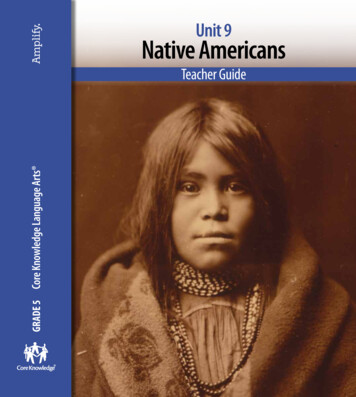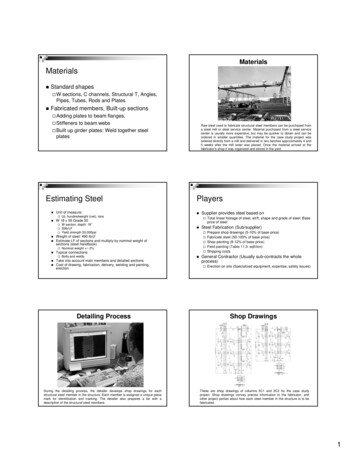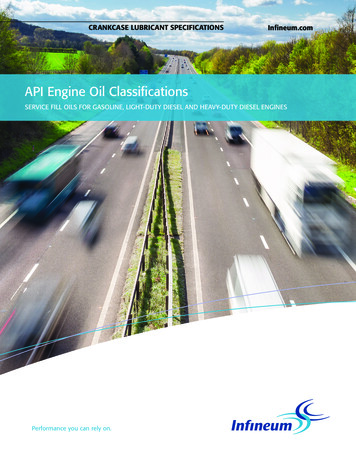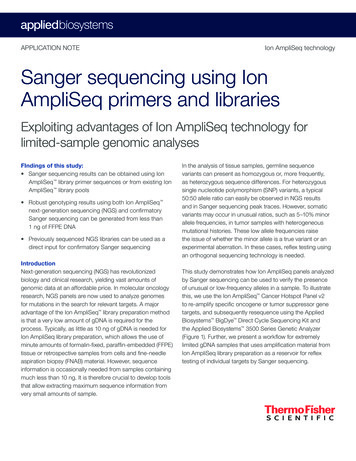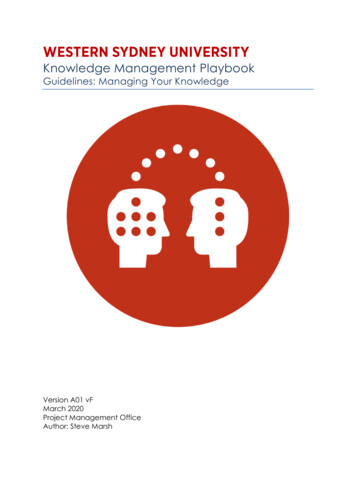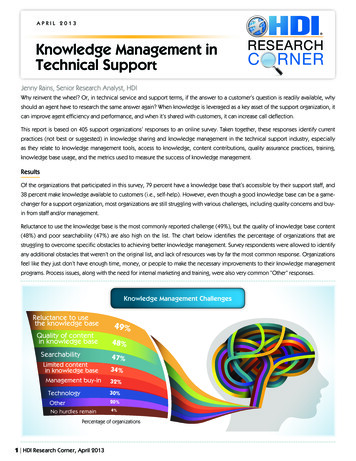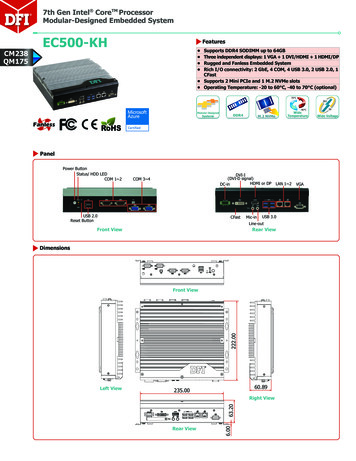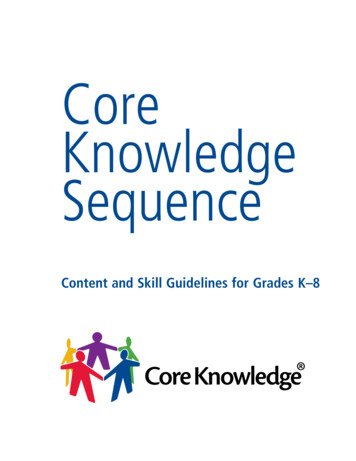
Transcription
CoreKnowledgeSequenceContent and Skill Guidelines for Grades K–8
PLEASE NOTE you are free: to Share — to copy, distribute and transmit the work to Remix — to adapt the workUnder the following conditions: Attribution — You must attribute the work in the following manner:This work is based on an original work of the Core Knowledge Foundation made available through licensing under a Creative CommonsAttribution-NonCommercial-ShareAlike 3.0 Unported License. This doesnot in any way imply that the Core Knowledge Foundation endorses the work. Noncommercial — You may not use this work for commercial purposes. Share Alike — If you alter, transform, or build upon this work, you maydistribute the resulting work only under the same or similar license tothis one.With the understanding that:For any use or distribution, you must make clear to others the licenseterms of this work. The best way to do this is with a link to this web 3.0/
Copyright 2013 Core Knowledge Foundationwww.coreknowledge.orgAll Rights Reserved.
ART DIRECTION AND DESIGN:COVER:Liza Greene and Holly LaniganLiza Greene 2010 Core Knowledge FoundationISBN978-1-890517-25-0First printing of Core Knowledge Sequence for Preschool–Grade 8Ninth printing of Core Knowledge Sequence for K–8Prior editions 1988, 1990, 1991, 1992, 1993, 1995, 1997, 1998, 1999 Core Knowledge FoundationThird printing of Core Knowledge Preschool SequencePrior editions 1997, 2000 Core Knowledge FoundationThe Core Knowledge Foundation hereby grants permission for individual reproduction of the Core KnowledgeSequence for noncommercial purposes. No part of this document may be reproduced or used in any other form orby other means—graphic, electronic, mechanical, including recording, taping and information storage and retrievalsystems—without prior written permission and license from the Core Knowledge Foundation.Requests for permission and license should be directed to:Core Knowledge Foundation801 East High StreetCharlottesville, VA 22902telephone: (434) 977-7550fax: (434) 977-0021e-mail: coreknow@coreknowledge.orghome page: www.coreknowledge.org“Core Knowledge” is a trademark of the Core Knowledge Foundation.
ContentsA Letter from the Founder . iPrefaceWhat's New in the 2010 Edition? . iiWhat Support is Available for Implementation of Core Knowledge . vIntroductionWhat is the Core Knowledge Sequence? . viTeaching the Core Knowledge Sequence . viThe Sequence as the Core of the Curriculum . viThe Consensus Behind the Core Knowledge Sequence . viiEqual Access to Knowledge Promotes Excellence and Fairness .viiiMulticulturalism in the Sequence .viiiThe Arts in the Curriculum . viiiCore Knowledge Schools . ixResources for Teaching the Core Knowledge Sequence . ixPreschoolPlease flip this publication over to view the Preschool Sequence.KindergartenOverview of Topics . 2Language Arts . 3World History and Geography . 12American History and Geography .13Visual Arts .15Music . 16Mathematics .18Science .20Grade 1Overview of Topics .24Language Arts .25World History and Geography . 35American History and Geography .37Visual Arts .39Music . 41Mathematics .43Science .45Grade 2Overview of Topics .50Language Arts .51World History and Geography . 61American History and Geography .63Visual Arts .66Music . 68Mathematics .70Science .73Grade 3Overview of Topics .78Language Arts .79World History and Geography . 83American History and Geography .85Visual Arts .88Music . 90Mathematics .92Science .95Grade 4Overview of Topics .100Language Arts .101
World History and Geography .105American History and Geography .109Visual Arts .112Music .114Mathematics .116Science .119Grade 5Overview of Topics . 124Language Arts . 125World History and Geography . 129American History and Geography .133Visual Arts . 136Music .138Mathematics . 140Science . 143Grade 6Overview of Topics . 148English .149World History and Geography . 153American History and Geography .158Visual Arts . 160Music .162Mathematics . 164Science . 168Grade 7Overview of Topics . 174English .175History and Geography . 180Visual Arts . 186Music .188Mathematics .190Science .193Grade 8Overview of Topics . 198English .199History and Geography .204Visual Arts . 210Music .212Mathematics . 214Science . 216Appendix AWhy Listening and Learning are Criticalto Reading Comprehension.Appendix BUsing Trade Books to Achieve College and Career Readiness:The Principles of Democracy.Appendix CDomains and Core Content Objectives for the Core Knowledge Language ArtsProgram, K–2.Appendix DCore Knowledge Grade-by-Grade Resource Recommendations.223227240266Core Knowledge at a Glance. 268
A Letter fromthe FounderThe CoreKnowledgeSequenceA Letter fromthe Founderof theCore KnowledgeFoundation, E. D. Hirsch, Jr.March, 2010Dear Friend of Core Knowledge,The Board of Trustees of the Core Knowledge Foundation has long desired to make the CoreKnowledge Sequence freely available for all non-commercial use. Frankly, what has held us backis simple economics. Even nonprofits need to pay bills, and the Sequence, our guide to the specificknowledge that forms the foundation of a sound, well-rounded education, has long been ourbiggest seller. Income from its sale allows us to break even so we can continue to advocate for asolid elementary curriculum and support a growing network of Core Knowledge schools.While Core Knowledge is still worried about breaking even, times have changed. Today, morepeople recognize that a core curriculum is critical to significant educational improvement.Growing acceptance of our fundamental proposition is now being evidenced in the promisingdecision of several states to get behind a common core of K–12 standards in language arts andmath. It would be contrary to our basic mission if we did not try to help this promising neweffort prosper and succeed.From its founding in 1986, Core Knowledge has worked to help teachers and parents understandthat all of our most important goals in education—reading comprehension, language competence,and critical thinking—depend on broad knowledge, and cannot be successfully attained throughlanguage-arts instruction alone. To their credit, the authors of our emerging common core statestandards understand this concept. However, standards alone are not sufficient to guaranteesuccess. The effectiveness of the new language-arts standards will depend on the implementationof coherent, cumulative, and content-specific grade-by-grade curricula infused into language artsand the other subjects.So the question has become not how can we give away our most valuable publication andfoundational piece of intellectual property, but how can we not?In the old sailing days you had to wait for the flood tide before setting forth, so you didn’t miss thetide. That, according to Shakespeare, was true for more than sea voyages:There is a tide in the affairs of men,Which, taken at the flood, leads on to fortune;Omitted, all the voyage of their lifeIs bound in shallows and in miseries.Or as Will Rogers put it: “Even though you are on the right track, you will get run over if you justsit there.”For those of you who are old hands on this voyage, thank you for your support throughout theyears. If you are new to Core Knowledge, welcome aboard. I have never been more optimisticabout the prospect for deep, meaningful, and lasting change in our schools.Sincerely,E. D. Hirsch, Jr.i
PrefacePreface to the 2010 Edition of theCore Knowledge SequenceWith the prospect that many states will soon embrace a common core of K–12 standards in languagearts and math, the future of the American public education system has never looked brighter thanright now.We at the Core Knowledge Foundation fervently believe that our experience over the past twentyyears in championing the use of a coherent, cumulative, content-specific curriculum in schoolsthroughout the United States can be of significant value to states and school districts nationwidelooking to take the next step forward at this historic moment. The integration of common corestandards in language arts and math with a coherent, cumulative, and content rich curriculum holdsenormous promise. The Core Knowledge Foundation stands ready to assist states, school districts,and individual schools in taking this step and it is for that very reason that we have decided todisseminate the Core Knowledge Sequence as widely as possible at no cost.We offer then this updated, 2010 online version of the Core Knowledge Sequence. Our originalmission—Excellence and Equity for All Children—and the simple, yet powerful underlying premiseof Core Knowledge, that knowledge builds on knowledge, remain unchanged. Nearly all of ourmost important goals for education—greater reading comprehension, the ability to think criticallyand solve problems, even higher test scores—are a function of the depth and breadth of ourknowledge. Although current events and technology are constantly changing, there is a body oflasting knowledge and skills that form the core of a strong Preschool through Grade 8 curriculum.Explicit identification of what children should learn at each grade level ensures a coherent approachto building knowledge across all grade levels, making efficient and effective use of instructional time.Every child should learn the fundamentals of science, basic principles of government, importantevents in history, essential elements of mathematics, widely acknowledged masterpieces of art andmusic from around the world, and stories and poems passed down from generation to generation.Over the past 20 years, we have been able to refine and fine tune the implementation of CoreKnowledge, thanks to the effort and feedback of thousands of teachers and schools who have putthe Core Knowledge Sequence into practice in real classrooms with real students. We have attemptedto reflect our increased wisdom with regard to effective implementation in this 2010 edition of theSequence.What’s New in the 2010 Edition?We call your attention specifically to the following revisions. Preschool and K–8 Guidelines in a Single DocumentThe Core Knowledge Sequence for grades 1–5 was first released in 1988. The addition ofkindergarten and the middle school grades soon followed, resulting in a single documentknown as the Core Knowledge Sequence for K–8, which is now in its ninth printing. In 1997,the Foundation published the Core Knowledge Preschool Sequence as a separate documentthat offered a coherent approach to teaching 3- to 5-year olds the specific content and skillsthat lay the foundation for future learning. The Core Knowledge Preschool program hasflourished in its own right since that time.By combining the Preschool Sequence with the K–8 guidelines, the Foundation is reassertingits firm commitment to a fully coherent approach to education that we believe is mosteffective when started at the earliest possible age.The two-page spread “Core Knowledge at a Glance” in this document graphically displaysan overview of this coherence across the grade levels.ii
Preface(continued) Explicit Integration of Content and SkillsIn the early years, in order to distinguish ourselves from other education reform effortsand approaches that focused on process over subject-specific content, we identified theCore Knowledge Sequence as a “set of content guidelines.” Core Knowledge and the CoreKnowledge Foundation became synonymous with content among knowledgeable educators.However, as sometimes happens, some began to portray Core Knowledge as an “either/or”proposition, i.e., if you were using Core Knowledge, you were focused only on content, notskills. Of course, nothing could be further from the truth. As successful Core Knowledgeschools have always known, Core Knowledge is more accurately described as a “both/and” proposition: effective Core Knowledge teachers know that both content and skills areessential; they embed the teaching of critical skills within the content they share with theirstudents. The skill objectives are most effectively targeted when they are anchored to thecontent in the context of a domain of knowledge. To that end, you will notice that we arenow explicitly referring to the Core Knowledge Sequence as “Content and Skill Guidelines”for preschool–grade 8. Increased Elaboration of the K–2 Language Arts Section of the SequenceAfter many years of hoping that commercial textbook publishers would heed the cognitivescience findings and insights about the link between reading comprehension andbackground knowledge and create new instructional materials for the teaching of reading,the Core Knowledge Foundation made the decision five years ago to raise the fundsnecessary to develop its own set of language arts materials. To date, we have created andfield-tested comprehensive materials for grades K–2 that represent a revolutionary newapproach to language arts instruction.While these materials, the Core Knowledge Language Arts (CKLA) program, are notyet available for widespread sale, we have included the CKLA goals and objectives forkindergarten–grade 2 in this 2010 edition of the Core Knowledge Sequence (see AppendixC, “Domains and Core Content Objectives for the Core Knowledge Language Arts Program,K–2”). These goals and objectives represent our best insights into what effective languagearts instruction should encompass—a broader view of “language” within the languagearts block, the coherent integration of rich content, i.e., nonfiction, within the languagearts block, and explicit, systematic instruction in phonics. Each of these points is furtherelaborated below and on the following page because we believe they are critical to realizingthe full potential of the Core Knowledge program.See the Core Knowledge Language Arts Program on our website for more completeinformation. A Broader View of Language—Listening, Speaking, Reading, and WritingShortly after a baby is born, an amazingly complex, interactive communication processbegins between the infant and others in the child’s environment. Listening and speakingare the primary means of communication during the early years of a child’s development. Itis important to understand that future reading and writing competencies are predicated oncompetencies in listening and speaking. Traditional language arts instruction has typicallypaid little attention to listening and speaking. This failure to focus on the development of orallanguage in language arts instruction is a serious oversight. The ability to read and writewritten language is highly correlated with students’ oral language proficiency and the abilityto understand a text read aloud is a prerequisite for making sense of the same text in printedform. By listening to written text read aloud, children can experience the complexities ofwritten language without expending cognitive energy on decoding. By then participatingin rich, structured conversations with an adult following the read aloud, children are ableto orally practice comparing, analyzing, and synthesizing ideas in written text in muchthe same way as they will be expected to do as independent readers in later grades. Thedecided advantage of this approach is that children are building these competencies in theiii
very early grades, instead of waiting for their own reading skills to evolve. This is especiallytrue for those children who start school, for whatever reasons, with less experience withprinted text. (See Hart & Risley, The Early Catastrophe: The 30 Million Word Gap by Age 3on our website.)We are long past due the need to recognize that early language disadvantage persists andmanifests itself as illiteracy when educational practices in elementary education fail torecognize the importance of oral language. It is essential that children build listening andspeaking competency while also developing reading and writing skills.See Appendix A, “Why Listening and Learning are Critical to Reading Comprehension,” fora further elaboration of why oral language is important and how the language arts block canbe reconceptualized to develop listening and learning skills. Coherent Integration of Content Within the Language Arts BlockWhile various reading approaches are increasingly including nonfiction selections within thelanguage arts block and textbook publishers are paying greater attention to reading in thecontent areas, they have typically failed to grasp the importance of developing a coherentapproach to building knowledge within grades and across grade levels. Children hearand/or read about dinosaurs one day, the five senses the next time a nonfiction selectionis presented, and Native Americans in the next unit. The selected texts have nothing incommon except that they are nonfiction. This random approach to content area reading failsto recognize how domain knowledge builds either within a grade or cumulatively acrossgrade levels. Incorporating nonfiction into language arts in this way is a missed opportunityand a waste of precious instructional time.Nonfiction selections that are integrated into the language arts block must be presented ina coherent, nonfragmented way. In developing the CKLA materials, we have used the gradespecific topics in history, science, music, and the arts from the Core Knowledge Sequenceas the basis of our selections, thereby maintaining the content coherence that has beenan integral part of Core Knowledge for the past 20 years. It has also been our experiencein field testing CKLA, that nonfiction selections should focus on a single topic or domainover a sustained period of time—about two weeks—rather than intermingle selections onunrelated topics.See Appendix A, “Why Listening and Learning are Critical to Reading Comprehension,”Appendix B, “Using Trade Books to Achieve College and Career Readiness: The Principlesof Democracy,” and Appendix C, “Domains and Core Content Objectives for the CoreKnowledge Language Arts Program, K–2,” for a detailed explanation of how to effectively andcoherently incorporate content in the language arts block. Explicit and Systematic Phonics InstructionThe Core Knowledge Foundation has long advocated the importance of explicitly andsystematically teaching young children the phonemic awareness and phonics skillsnecessary to decipher the written code. It is important that as teachers work to moreintentionally include content within the language arts block, they not lose sight of theimportance of teaching specific decoding skills, especially in the early grades. The CKLAmaterials use a synthetic phonics approach that has proven to be very effective in early fieldtesting. The 2010 edition of the Sequence includes the grade specific decoding skills that arethe focus of the CKLA materials for K–2. We plan to start development of CKLA materialsfor grades 3–5 in the near future and will post revised language arts goals for these gradesas part of the online Sequence as soon as they are available.The specific sequence of consonant and vowel sounds and spellings included in theSequence at each grade level, K–2, represents what is taught in CKLA and is unique toiv
the CKLA materials. Until such time as these materials are available for sale, it may bedifficult for schools to reproduce the teaching of this exact sequence of phonics skills atthe designated grade levels. In the interim, we urge schools to use other materials thatexplicitly and systematically teach the same consonant and vowel sounds and spellings overthe course of K–2, although when certain sounds and spellings are introduced may differ.See “Reading Program Recommendations” on our website for our suggestions as to whichexisting, commercially available materials do use a systematic and explicit approachto teaching phonics; despite the claims to include phonics, many, many basal readingprograms do not do so in a systematic way.What Support is Available for Implementation of Core Knowledge?The Core Knowledge Foundation is ready and able to assist states, districts, and individual schoolswho want to join the ranks of those who are successfully implementing Core Knowledge. The newlyrevised Core Knowledge website (www.coreknowledge.org) offers a wealth of information on how toget started, support materials and professional development (also, see Appendix D, “Core KnowledgeGrade-by-Grade Resource Recommendations” in this document) as well as many free onlineresources. Be sure to check out the new online search engine that will allow you to search for lessonplans on Core Knowledge topics!Please do not hesitate to also contact us directly by phone (434-977-7550) or by e-mail:(coreknow@coreknowledge.org).v
IntroductionIntroductionWhat Is the Core Knowledge Sequence?The Core Knowledge Sequence is a detailed outline of specific content and skills to be taught inlanguage arts, history, geography, mathematics, science, and the fine arts. As the core of a school’scurriculum, it is intended to provide a coherent, content specific foundation of learning, whileallowing flexibility to meet local needs.The Sequence represents an effort to describe and state the specific core of shared knowledge that allchildren should learn in U.S. schools, and that speakers and writers assume their audience knows.It should be emphasized that the Core Knowledge Sequence is not a list of facts to be memorized.Rather, it is a guide to coherent content from grade to grade, designed to encourage cumulativeacademic progress as ch
In the early years, in order to distinguish ourselves from other education reform efforts and approaches that focused on process over subject-specific content, we identified the Core Knowledge Sequence as a "set of content guidelines." Core Knowledge and the Core Knowledge Foundation became synonymous with content among knowledgeable educators.
